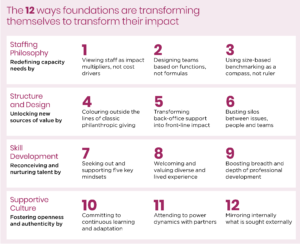Introduction by Julian Corner to Special Issue of Alliance: “This special feature explores a growing aspiration in philanthropy to achieve system-level change. It looks at the potential and pitfalls by profiling a number of approaches adopted by different foundations
While the fortunes of systems thinking have ebbed and flowed over the decades, it has mainly occurred on the margins of
I detect at least four broad approaches or attitudes to systems in foundations’ work, all of which have been at play in Lankelly Chase’s work at different points:
1.The system as a unit of intervention
Many foundations are trying to take in a broader canvas, recognising that both problems and solutions are generated by the interplay of multiple variables. They hope to find leverage points among these variables, so that their investment can unlock so-called system-level change. Some of their strategies include: working for policy changes, scaling disruptive innovations, supporting advocacy for people’s rights, and improving the evidence base used by system actors. These approaches seem to work best when there is common agreement on an identifiable system, such as the criminal justice system, which can be mapped and acted on.
2.Messy contested systems
Some foundations find they are drawn deeper into complexity. They unearth conflicting perspectives on the nature of the problem, especially when there is a power inequality between those defining it and those experiencing it. As greater interconnection emerges, the frame put around the canvas is shown to be arbitrary and the hope of identifying leverage points begins to look reductive. One person’s solution turns out to be another’s problem. Unable to predict how change might occur, foundations shift towards more exploratory and inquiring approaches. Rather than funding programmes or institutions, they seek to influence the conditions of change, focusing on collaborations, place-based approaches, collective impact, amplifying lesser heard voices, building skills and capacities, and reframing the narratives people hold.
3.Seeing yourself in the system
As appreciation of interconnection deepens, the way foundations earn money, how they make decisions, the people they choose to include in (and exclude from) their work, how they specify success, all come into play as parts of the system that need to change. These foundations realise that they aren’t just looking at a canvas, they are part of it. At Lankelly Chase, we now view our position as fundamentally paradoxical, given that we are seeking to tackle inequality by holding accumulated wealth. We have sought to model the behaviours of healthier systems, including delegated decision-making, mutual accountability, trust-based relationships, promoting equality of voice. By aiming for congruence between means and ends, we and our peers contend that effective practice and ethical practice become the same.
4.Beyond systems
There comes a point when the idea of systems itself can feel reductive. Different values are invoked, those of kindness and solidarity. The basis on which humans relate to each other becomes the core concern. Inspiration is sought in other histories and forms of spiritualty, as suppressed narratives are surfaced. The frame of philanthropy itself is no longer a given, with mutuality and even reparation becoming the basis of an alternative paradigm.
….Foundations can be viewed as both ‘of’ and ‘outside’ any system. This is a tension that isn’t resolvable, but if handled with sufficient self-awareness could make foundations powerful systems practitioners

